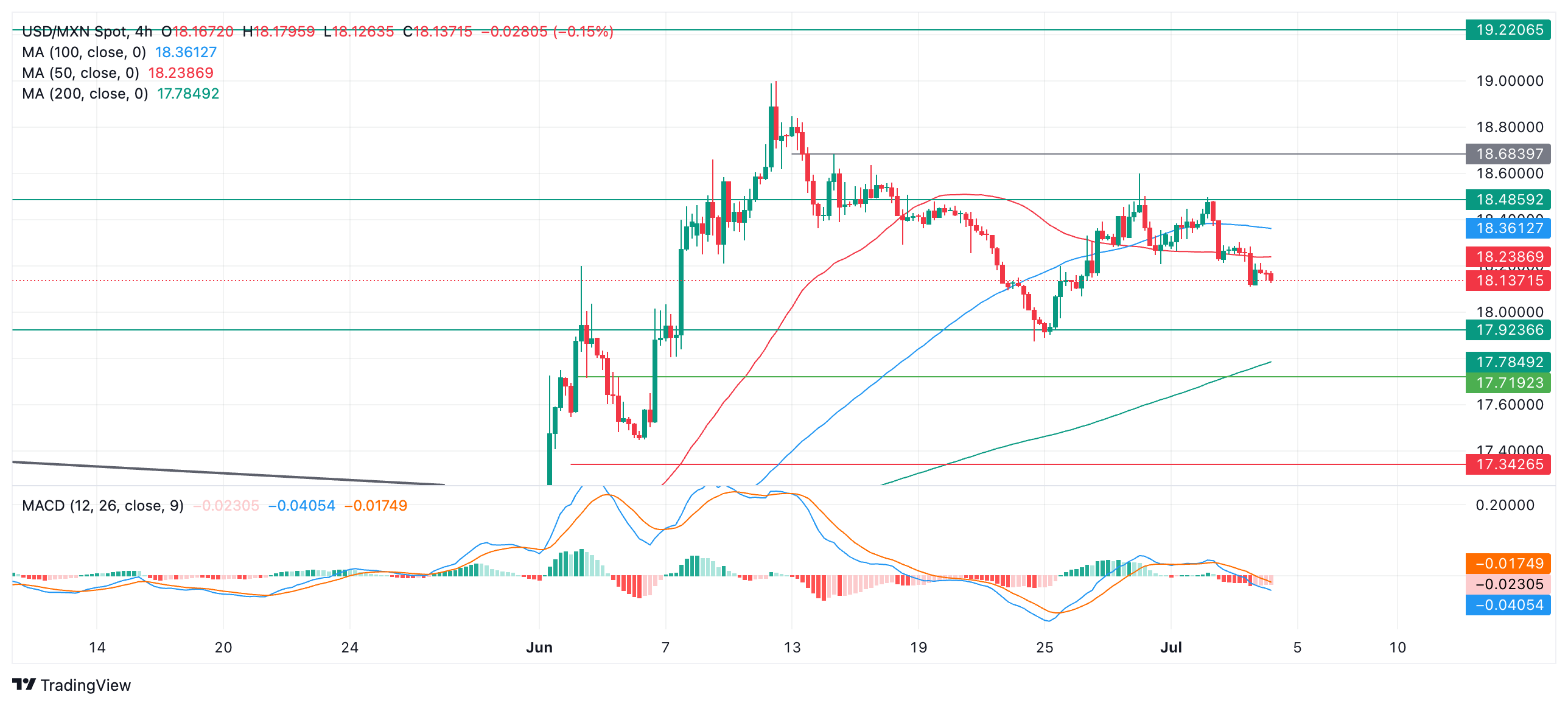- The Mexican peso rose following comments from Banxico deputy governor Jonathan Heath suggesting that interest rates should remain high.
- EUR/MXN and GBP/MXN are trading flatter as political risk in Europe eases, supporting the Euro and Pound.
- USD/MXN is down in a staggered decline towards 18.00.
The Mexican Peso (MXN) is rising against its key peers on Thursday, although it is gaining more strength against the US Dollar (USD) on the back of a recent string of poor US economic data than against its European counterparts. Comments from Bank of Mexico Deputy Governor Jonathan Heath have provided the Peso with a tailwind.
At the time of writing, one US Dollar (USD) buys 18.13 Mexican Pesos, EUR/MXN is trading at 19.58 and GBP/MXN at 23.12.
The Mexican Peso receives a boost after a publication on the social network X
The Mexican peso is gaining ground after recent comments by Banxico deputy governor Jonathan Heath suggested he is in no rush to vote for interest rate cuts due to still-high inflation.
Heath said on social media X that he “agrees with Jerome Powell, more benign inflation data is needed before cutting rates. He (Powell) said it for the Federal Reserve, but the same applies to the case of Mexico.”
Her comments differ from those of Banxico Governor Victoria Rodríguez Ceja, who recently said that progress had been made in disinflation, which “allows us to continue discussing downward adjustments to our rate, and I believe that this is what we will be doing in our next monetary policy meetings.”
Evidence that the US economy is cooling
The US dollar weakened across the board after a raft of data released on Wednesday provided further evidence that the US economy is cooling.
The ISM Services Purchasing Managers’ Index (PMI) revealed a slowdown in the sector, which economists have pointed to as a primary driver of high inflation. The June reading showed a drop to 48.8 from 53.8 in May, well below the consensus estimate of 52.5. It was the “weakest since May 2020 during the Covid-19 pandemic,” according to Jim Reid, head of Global Macro Research at Deutsche Bank. Although the Services Prices Paid component remained in expansion territory at 56.3, it was still lower than May’s 58.1.
US employment data was also disappointing. Initial claims for US jobless benefits rose to 238,000 in the week ending June 29, higher than estimates of 235,000 and 233,000 the previous week.
This “pushed the 4-week moving average to 238.5k, which is the highest since August,” Deutsche’s Reid added. At 1.858 million, Continuing Claims stood at their highest level since November 2021. To top it off, ADP’s Employment Change indicator for June, which measures the number of new private payroll employees, showed an increase of 150,000, which was lower than May’s figure and the 160,000 forecast by economists.
Minutes from the Federal Reserve’s June meeting were also released on Wednesday, and these maintained the neutral, data-dependent rhetoric of the days leading up to Powell in Sintra. Essentially, the Fed said it wanted to see more progress on inflation, which was still at 2.7% (before more recent data showed a drop to 2.6%), and weaker economic data overall before hitting the interest rate cut button.
French bond spreads narrow as election risk recedes
The Mexican Peso is trading in a range against the Euro, which continues to recover as risks diminish that France’s far-right National Rally (RN) party will win an overall majority in the second round of French elections on Sunday.
This is reflected in the spread between French and German yields, which narrowed further on Wednesday. “The Franco-German 10-year spread (-5.0 bps) fell to its narrowest level in three weeks, at 67 bps,” according to Deutsche Bank’s Jim Reid, in a sign that investors are pricing in less risk of an outright victory by extremist parties in the French election.
The Pound in the spotlight on election day
The British Pound (GBP) is also holding firm against the Mexican Peso on the day of the UK general election. Polls have shown the centre-left Labour Party consistently in the lead by a wide margin of around 20 points, which translates to them likely to win a large majority of seats.
While most economists agree that whatever the future government is, it will have little fiscal room for manoeuvre, there is an argument that greater political stability could support both the economy and the pound in the future.
Technical Analysis: USD/MXN looks increasingly range bound
The USD/MXN is moving lower after hitting the June 28 swing high at 18.59. It is currently moving towards the key June 24 low at 17.87. The pair may be entering a sideways trend although it is still a bit early to be sure.
USD/MXN 4-hour chart
A break below 18.10 would suggest an extension towards probably the vicinity of the June 24 low. At that point, the price is likely to consolidate. If it starts an up leg, it could be a sign that the pair is entering a sideways trend. Alternatively, a decisive break below 17.87 would likely suggest that a new downtrend was in play, with the next target from there at 17.50 (50-day SMA).
A break above 18.59, however, would suggest a continuation to 18.68 (June 14 high), followed by 19.00 (June 12 high). A break above 19.00 would provide strong confirmation of a resumption of the short- to medium-term uptrends.
The direction of the long-term trend remains uncertain.
Economic indicator
ADP Employment Report
The employment data is prepared by Automatic Data Processing Inc. The U.S. nonfarm private sector payrolls index is published monthly in collaboration with Moody’s Analytics. It is an estimate of the change in the number of people employed in the U.S. nonfarm private sector. A positive number means that the private sector saw an increase in payrolls, while a negative number means that the private sector saw a decrease. Figures that exceed expectations are generally positive for the dollar, while figures that fall short are negative.
Latest Post: Wed Jul 03, 2024 12:15 PM
Frequency: Monthly
Current: 150K
Dear: 160K
Previous: 152K
Fountain: ADP Research Institute
Traders often consider employment figures from ADP, the largest payrolls provider in the United States, to be the harbinger of the Bureau of Labor Statistics’ Nonfarm Payrolls release (usually released two days later), due to the correlation between the two. The overlap of both series is quite high, but in individual months, the discrepancy can be substantial. Another reason currency traders follow this report is the same as with the NFP: vigorous and persistent growth in employment numbers increases inflationary pressures, and with them, the likelihood of the Fed raising interest rates. Actual figures that beat consensus tend to be bullish for the USD.
Source: Fx Street
I am Joshua Winder, a senior-level journalist and editor at World Stock Market. I specialize in covering news related to the stock market and economic trends. With more than 8 years of experience in this field, I have become an expert in financial reporting.








